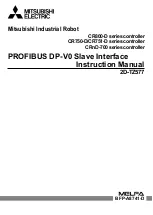
3
Features and Specification of 2D-TZ577 Card
Features of 2D-TZ577 Card
3
- 5
(*1)
Number of the option slots varies with the Controller you use.
CR1D: Provided only with
Slot 1.
CR2/3D: Provided with Slots 1 thru 3 (only one of the three slots used to install the Card at any one time)
Details about PROFIBUS
To learn more about PROFIBUS, visit a Japan PROFIBUS Association website at
3.2 Features of 2D-TZ577 Card
The 2D
-TZ577 Card has the following features:
(1)
Compliance with EN 50170
Volume
2 (Part 1, 2, 3, 4, and 8)
Designed to provide compliance with EN 50170
Volume
2 (Part 1, 2, 3, 4, and 8), the 2D
-TZ577 Card
serves only as
a slave station in a PROFIBUS DP-V0
network.
(2)
PROFIBUS DP
-
V0 Slave Interface Card for
D-Type Robot Controller
The 2D
-TZ577 Card is an optional card for use with the stand-alone type (D type) Robot Controller, not
usable f
or iQ Platform compatible type (Q type or R type).
To connect iQ Platform compatible type (Q type
or R type) Robot Controller to a PROFIBUS DP network, use a MELSEC
-
Q Series PROFIBUS DP unit.
To connect R type Robot Controller to a PROFIBUS DP network, use
a MELSEC iQ
-
R Series PROFIBUS
DP unit.
(3)
Input/output data communications with Class 1 Master Station
The 2D
-
TZ577 Card is capable of conducting input/output data communications with PROFIBUS
-
DP Class
1 Master Station (Master Station which communicates with Slave Stations on a cyclic basis).
This card is
intended to serve as a slave station which supports PROFIBUS DP-V0 capabilities. It does not
support PRORIBUS DP-V1 or PROFIBUS DP-V2 which is an extension of PROFIBUS DP-V0.
(a) Communicatable number of pieces of data
A single 2D
-TZ577 Card allows communications in the following number:
Input data
-
122 words maximum
Output data -
122 words maximum
(4)
Communications with Class 2 Mater Station
The 2D
-TZ577 Card is capable of conducting communications, as detailed b
elow, with Class 2 Master
Station (Master Station for network administration which takes care of startup, maintenance and diagnosis
services).
• Reading from input send area/output receive area
•
Reading I/O configuration information
• Changing station numbers
For instructions on using the each of the listed functions, see instruction manual which is supplied with
Class 2 Master Station being installed.
192 words in
combined total






























